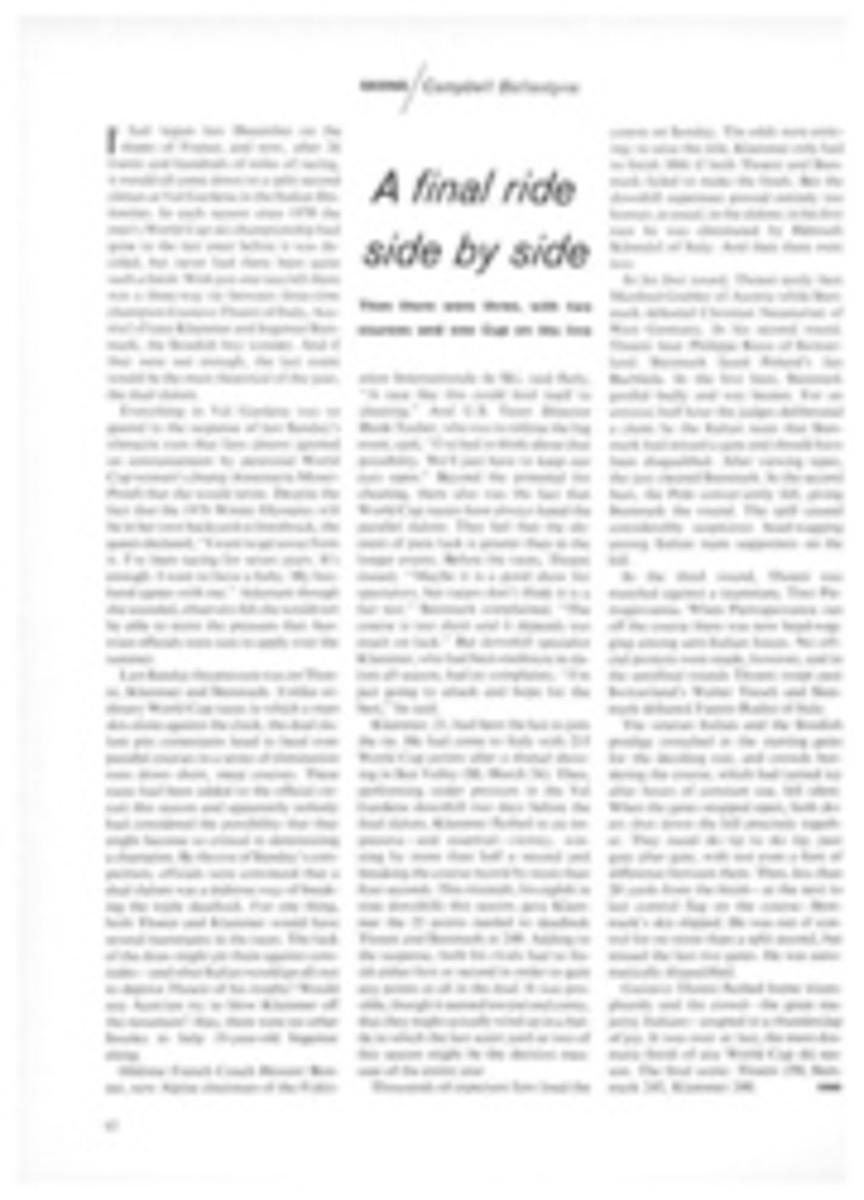
PACK SAUSAGE CHIPS, SPINACH DUST, PANCAKE FLAKES—AND FARE THEE WELL
In the horsehide-and-carbine past, one knew what to expect of camp and trail food—cold, burnt trout, raw-fried potatoes and the everyday ecstasy of beans. This oldtimers' fare continues to be lauded by outdoor writers, though one wonders why.
The alternative is freeze-dried food, which is not all rumor suggests or memory expects. The banal and bitter powdered eggs of WW II fame have moved into the Space Age. One is now tempted by glittering packets of shrimp creole, lasagna, raspberry-apple crunch, tuna salad and cottage cheese.
The process is relatively simple. Prepared food is flash-frozen, as if for the supermarket, then placed in vacuum chambers, and through the magic of technology the ice in the food is converted into a gas, which is pumped from the chamber. The food retains most of its flavor, but only 10% of its weight in water.
"When freeze-dried products first came on the market, even my dog wouldn't touch them," says a saleswoman at Eastern Mountain Sports in Boston. "Now our staff munches shrimp and banana chips all day long."
The advantages of freeze-dried foods are obvious. In terms of weight, four medium-sized cooked pork chops can be reduced to two ounces, so you can hang by ropes from the north face of the Eiger and enjoy a Mom's dinner, having expended only two ounces of agony getting it to 13,000 feet. Ease in preparation is another factor. Adding water to most foods and letting them stand is all that is necessary. Also the mixes seemingly have a life as long as plutonium. "We've been making freeze-dried foods for only 12 years," says Mickey Lancer of Oregon Freeze Dry Foods Inc. (in Albany), the world's largest producer, "so we still don't have data on deterioration. It's safe to say, though, that most freeze-dried foods can be left in a summer camp or a survival pack for four or five years."
But does it really taste like food? Can man live by freeze-dried stuff alone? It is not that these preparations taste bad or not at all. They are, in fact, better than the dreary frozen dinners in supermarket cases, and put to shame the fast-food palaces that line the approaches to most American towns.
The problem is texture. Since most freeze-dried main courses are mixtures of meat and vegetables—stews, in essence—a constant diet of them leaves you feeling as though you were on some impossibly elegant Skid Row where you staggered from one lavish mission to the next complaining of too much tarragon in St. Luke's chicken amandine.
The visual aspect of freeze-dried food is also unfortunate. The mixtures look like the glorified dry soup sold in markets. The vegetables, meat combinations and noodles are miniaturized, as if they were a scale-model kit at F.A.O. Schwarz—"Build your own dinner! 280 easy-to-assemble pieces!" Of course, they become bite-size when rehydrated. The meat products take some getting used to. Wilson's freeze-dried pork chops, for instance, come packed in a two-ounce can and resemble huge tablets of anemic peat moss. When water is added and they swell and are browned in a frying pan, the tablets become perfect circles of meat-boneless, fatless and characterless.
But you can live on these foods forever, since most contain up to 50% protein. If you use freeze-dried foods on camping trips and backpacking expeditions or at a summer cottage, here are some tips you should follow. Always let the product rehydrate several minutes longer than the directions suggest. Chewing on half-hydrated cubes of turkey is gruesome. If space and weight aren't critical on your expedition, take along a pot. Most manufacturers construct their foil pouches in such a way that the water and food may be mixed in them, but these almost always burn your fingers, and eating from aluminum foil makes your fillings ache in anticipation.
The main drawback to freeze-dried foods is cost. "Most of us can't afford to eat them three meals a day," says the Eastern Mountain Sports saleswoman, "or even once a day. My family takes along two or three dinners for a seven-day trip to brighten up the usual canned spaghetti and beans."
The following tasty menu for two will cost you $14.99. Breakfast: Mountain House Sausage Patties ($2.55) and Rich-Moor Blueberry Pancakes (80¢). Lunch: EMS brand Beef Stew ($2.35) and Mountain House Cocoa (30¢). Snacks: Rich-Moor Banana Chips (89¢) and Mountain House Plums ($1.25). Dinner: Rich-Moor Beef Stroganoff ($3.75), EMS Spinach Savory ($1.70) and Mountain House Ice Cream ($1.40).
If you feel that freeze-dried foods are a mad fancy of science, you may be disappointed. Underdeveloped countries can be supplied in part with freeze-dried food, with its marvelous storage capabilities, rather than depending on the annual vagaries of harvests and prices. As women ignite their apron strings in more affluent parts of the world, the freeze-dried dinner will replace the frozen glop now eaten by lonely husbands. And as we move out to the stars, freeze-dried peas will be taken on the long run to Pluto. Oregon Freeze Dry Foods even now sells survival units to the military, as well as catering to the needs of NASA. The company's freeze-dried Stroganoff will be a nice bit of culinary detente in the upcoming U.S.-Russian Skylab mission.
The only way to retaliate against hordes of the post-hippie generation swarming through the suburbs, gnawing space food sticks and swilling Tang, will be to sit down to an elegant freeze-dried Beef Wellington. Let us hope that somewhere in France a madman is developing a decent powdered '57 Lafite-Rothschild for those lazy summer evenings in our V-8 campers.

